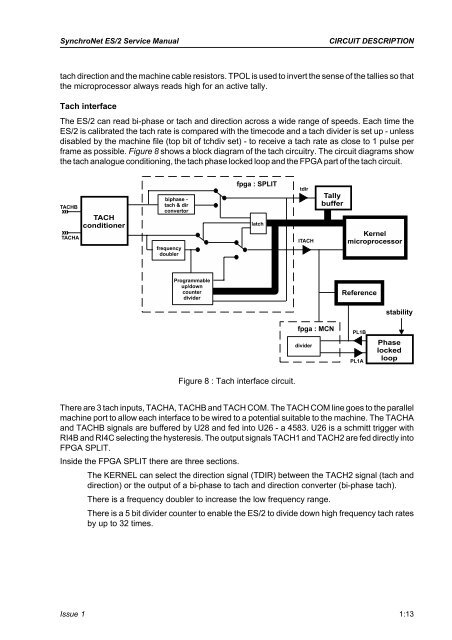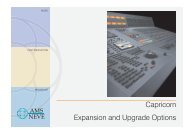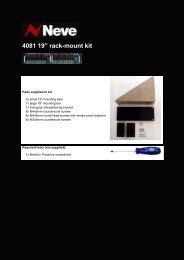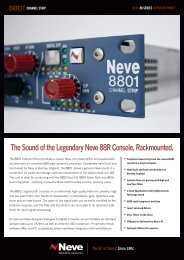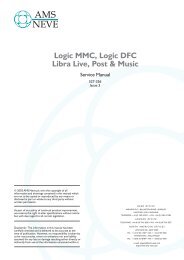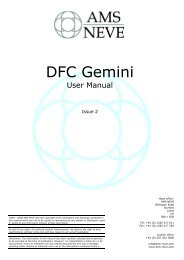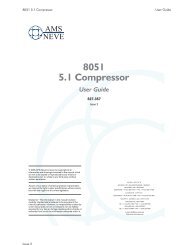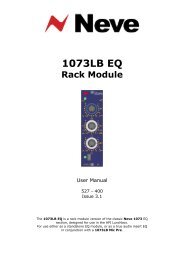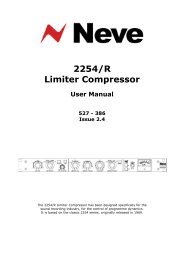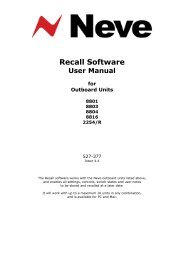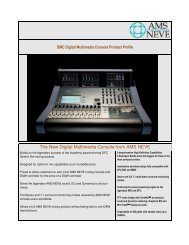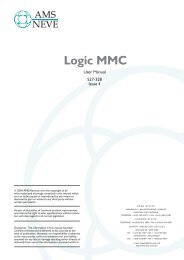Service Manual - AMS Neve
Service Manual - AMS Neve
Service Manual - AMS Neve
You also want an ePaper? Increase the reach of your titles
YUMPU automatically turns print PDFs into web optimized ePapers that Google loves.
SynchroNet ES/2 <strong>Service</strong> <strong>Manual</strong><br />
CIRCUIT DESCRIPTION<br />
tach direction and the machine cable resistors. TPOL is used to invert the sense of the tallies so that<br />
the microprocessor always reads high for an active tally.<br />
Tach interface<br />
The ES/2 can read bi-phase or tach and direction across a wide range of speeds. Each time the<br />
ES/2 is calibrated the tach rate is compared with the timecode and a tach divider is set up - unless<br />
disabled by the machine file (top bit of tchdiv set) - to receive a tach rate as close to 1 pulse per<br />
frame as possible. Figure 8 shows a block diagram of the tach circuitry. The circuit diagrams show<br />
the tach analogue conditioning, the tach phase locked loop and the FPGA part of the tach circuit.<br />
TACHB<br />
TACHA<br />
TACH<br />
conditioner<br />
biphase -<br />
tach & dir<br />
convertor<br />
frequency<br />
doubler<br />
fpga : SPLIT<br />
latch<br />
tdir<br />
ITACH<br />
Tally<br />
buffer<br />
Kernel<br />
microprocessor<br />
Programmable<br />
up/down<br />
counter<br />
divider<br />
Reference<br />
stability<br />
fpga : MCN<br />
divider<br />
PL1B<br />
PL1A<br />
Phase<br />
locked<br />
loop<br />
Figure 8 : Tach interface circuit.<br />
There are 3 tach inputs, TACHA, TACHB and TACH COM. The TACH COM line goes to the parallel<br />
machine port to allow each interface to be wired to a potential suitable to the machine. The TACHA<br />
and TACHB signals are buffered by U28 and fed into U26 - a 4583. U26 is a schmitt trigger with<br />
RI4B and RI4C selecting the hysteresis. The output signals TACH1 and TACH2 are fed directly into<br />
FPGA SPLIT.<br />
Inside the FPGA SPLIT there are three sections.<br />
The KERNEL can select the direction signal (TDIR) between the TACH2 signal (tach and<br />
direction) or the output of a bi-phase to tach and direction converter (bi-phase tach).<br />
There is a frequency doubler to increase the low frequency range.<br />
There is a 5 bit divider counter to enable the ES/2 to divide down high frequency tach rates<br />
by up to 32 times.<br />
Issue 1 1:13


